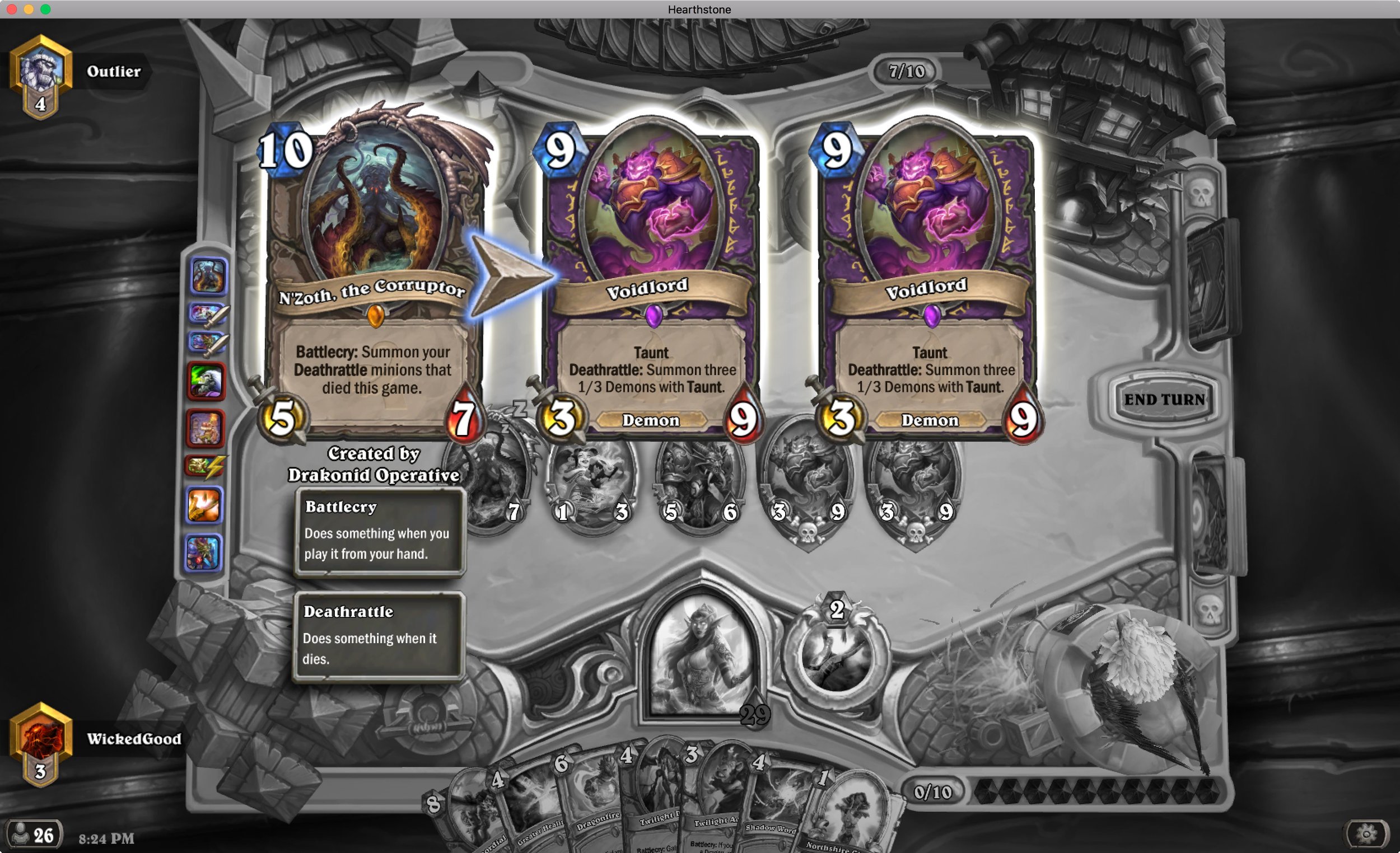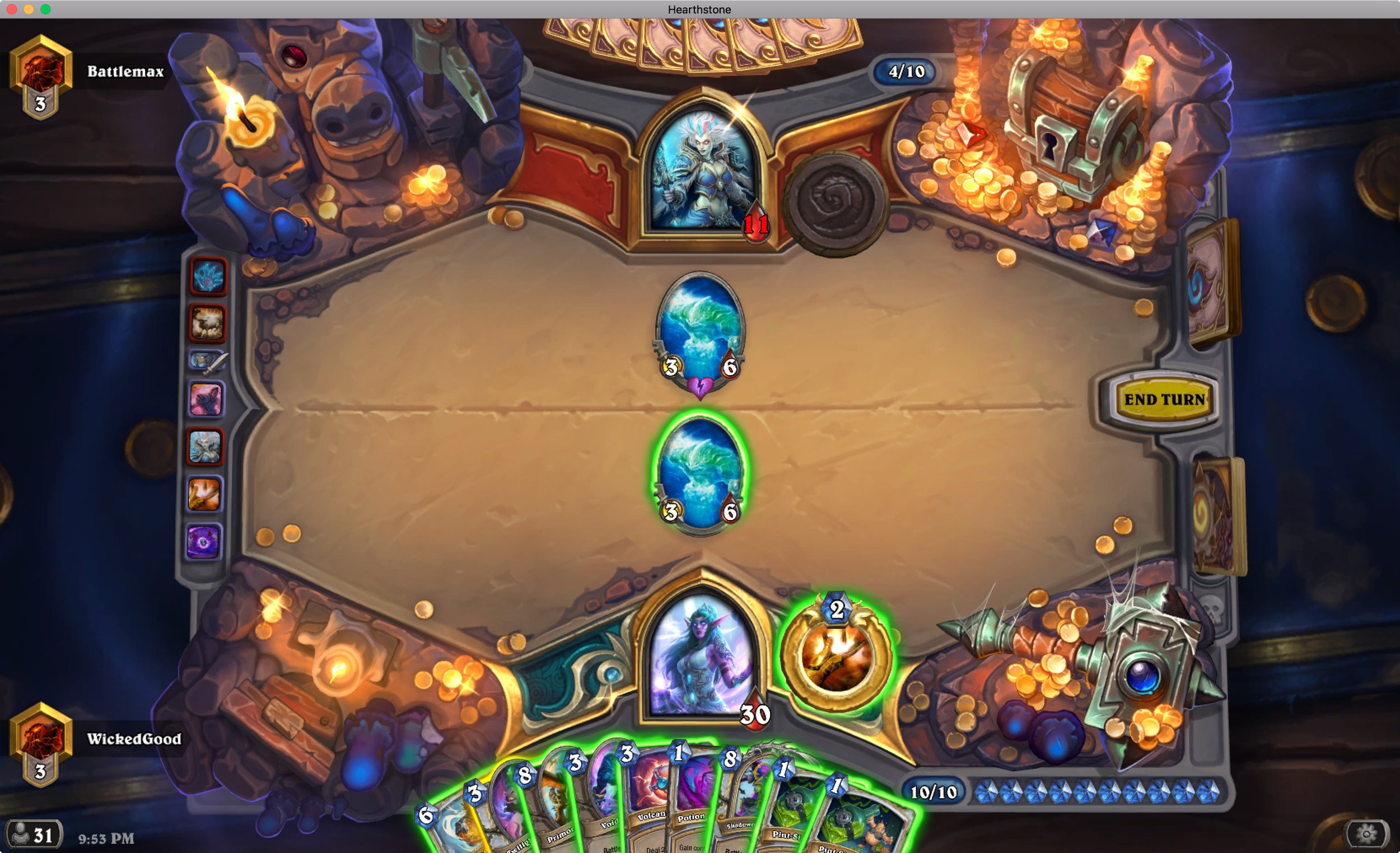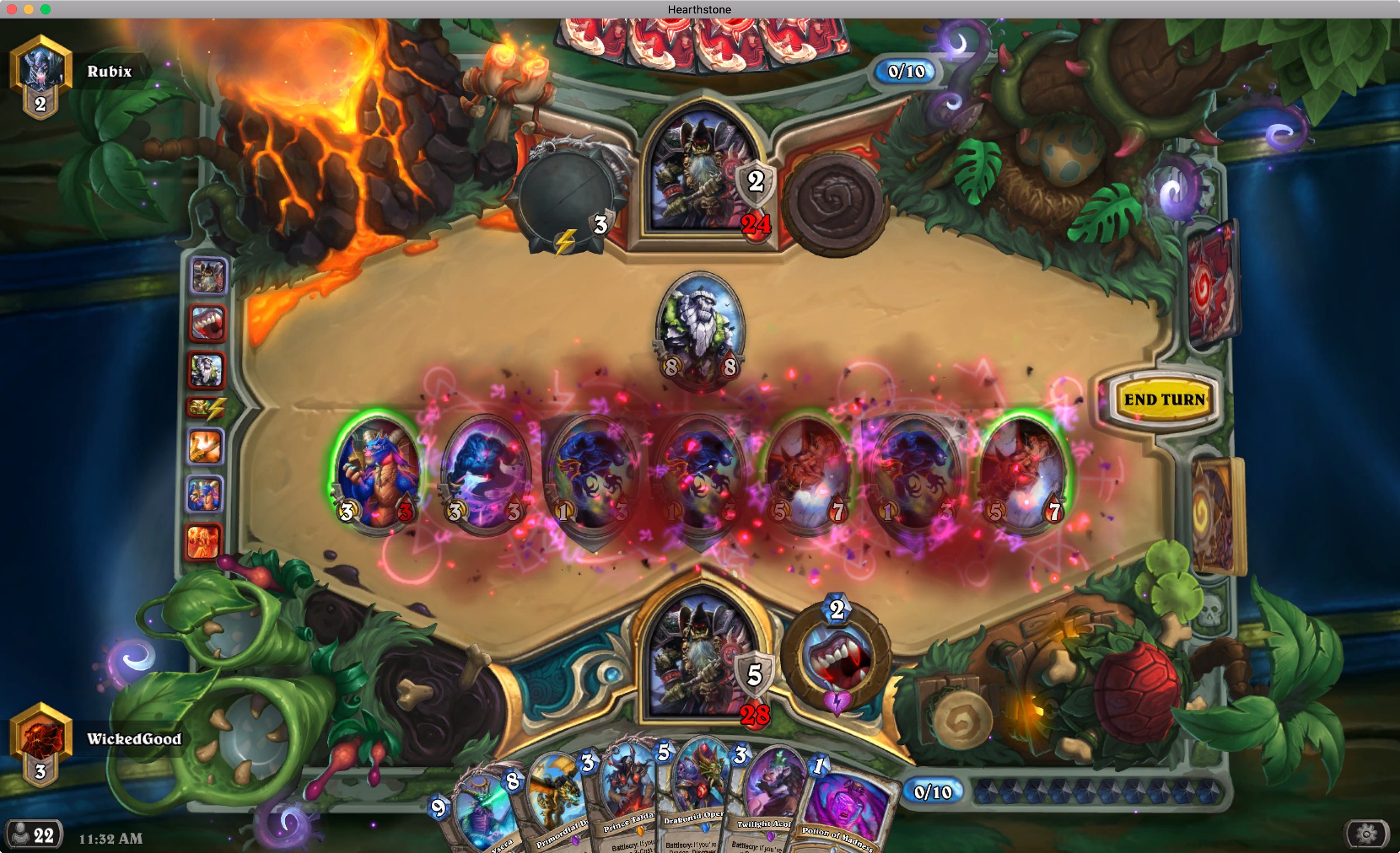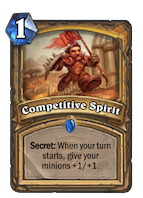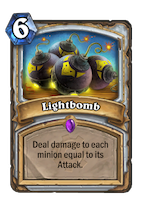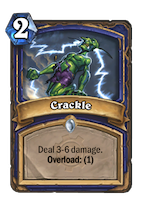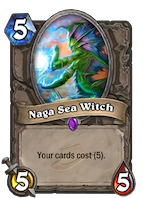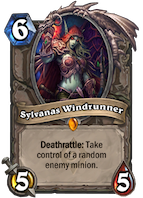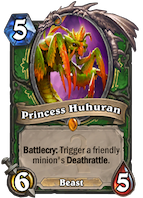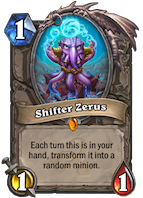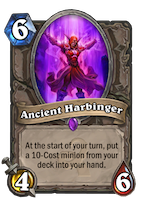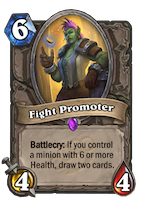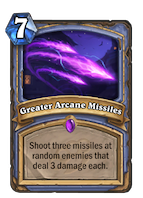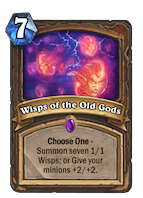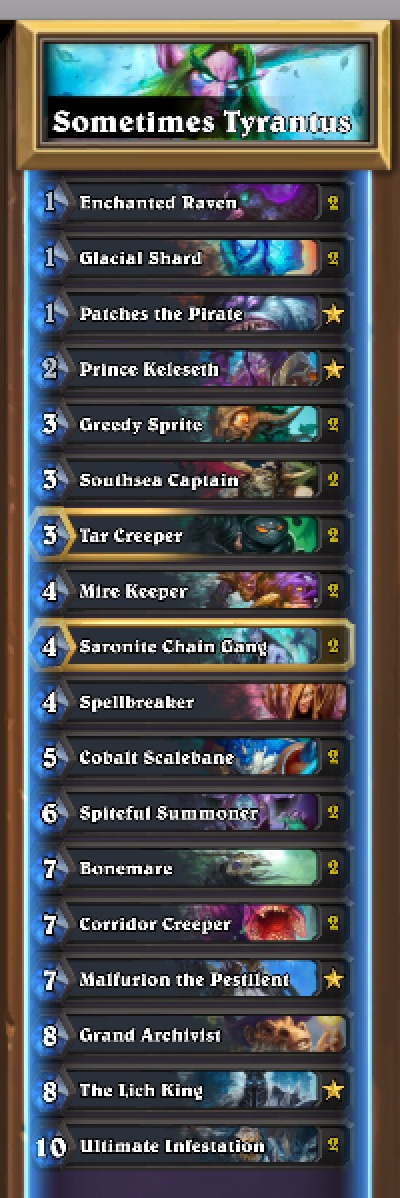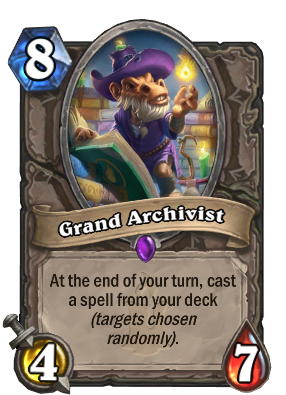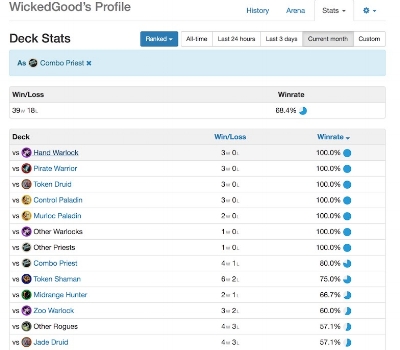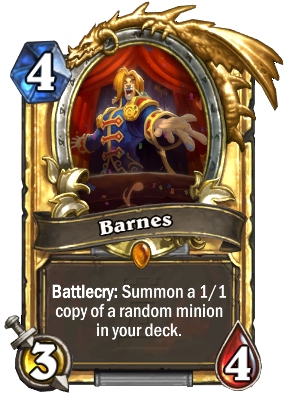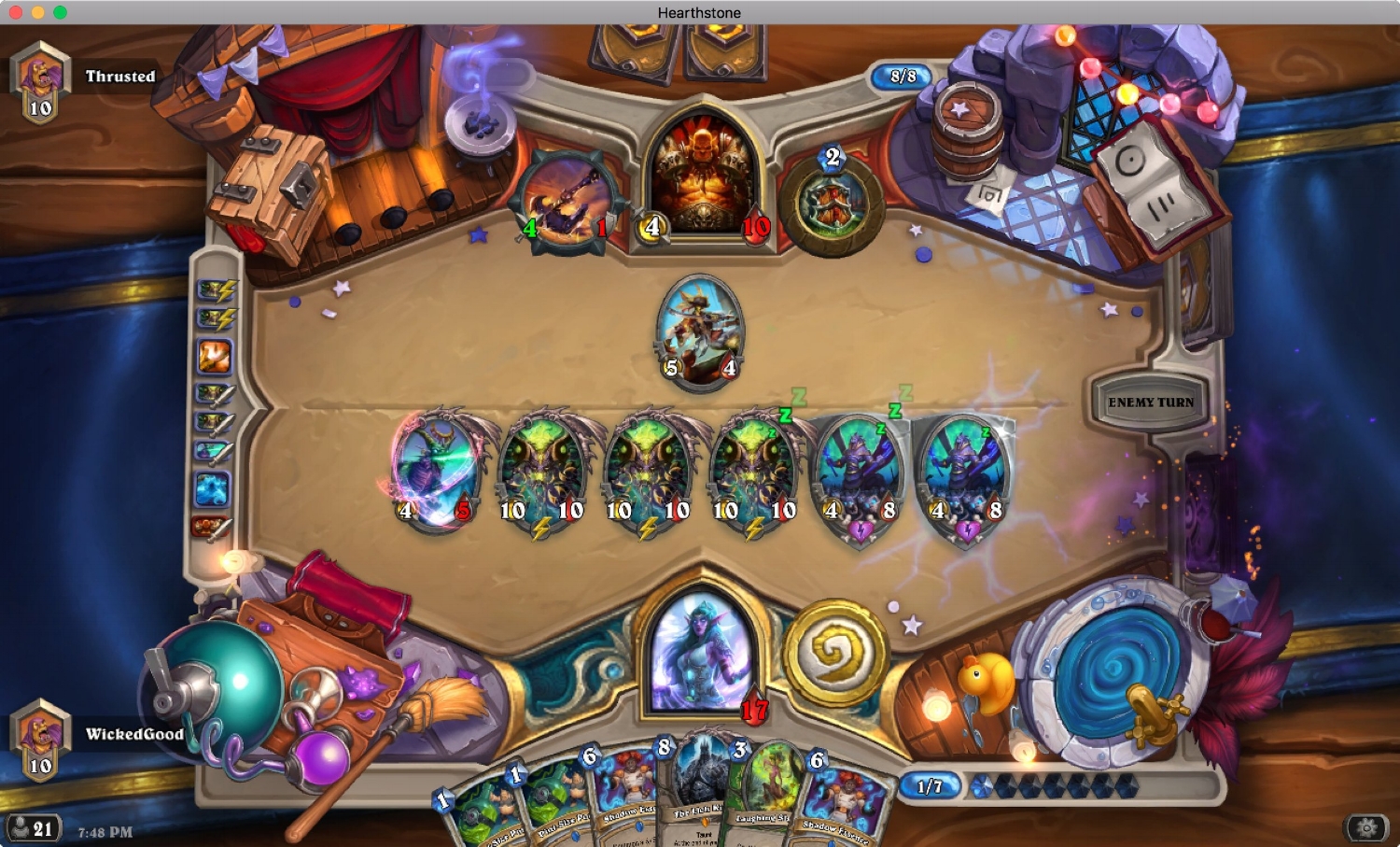Control Priest Without Barnes?
What a world, right? Turns out it’s better to play with your opponent’s Voidlords than it is to play with your own Obsidian Statues. Who knew?
That's a nice N'zoth you have there...
(Updated 3/16/2018 - Removed Dragonfire Potion and added Shadow Word: Death.)
Seriously, Dragon Control Priest (or just Control Priest, because despite my best efforts no one thinks of Big Priest as a Control deck), is well situated for a meta overrun with Warlocks and Paladins. You have board clears for days between four dragons with battlecries that damage the board alongside Dragonfire Potion and Shadow Word: Horror, as well as healing to stabilize and early minion pressure to help keep the board in a manageable state and help the board clears along.
One other thing that works in this deck's favor is the variety of relevant priest decks in the meta right now. Your early game looks identical to Spiteful Priest and Combo Priest up until you play a Shadow Word: Horror. There's not a great way to mulligan against this deck to begin with, but even if there was, this list is probably third or fourth on the list of decks your opponents are worried about. Depending on how long you can maintain that charade, you can even take your opponent completely off guard with Pint-Size Potion into Shadow Word: Horror or Cabal Shadow Priest. Sometimes, at high ranks, the extra couple of win rate percentage points due to the surprise factor matters.
Fair warning: This is a difficult deck to play optimally. Patience is crucial; you have a lot of board clears, but if you use one too early, or don't line up your answers properly to what you're facing, you're going to have a bad time. Very often, you're going to need to think outside the box and use creative combinations of cards to get yourself out of situations; it's easy to misplay, and misplays tend to get punished hard. Not to mention there are several cards that you may not be used to using, like...
Wait, Void Ripper? Seriously?
Seriously.
Meet Void Ripper. It's available for weddings and Bar Mitzvahs.
Void Ripper is the Swiss Army Knife of this deck, and I honestly wouldn’t play this deck without it. Like the old PlayStation commercials used to claim, “It only does everything.” With Pint Sized Potion, it’s a board clear for anything that’s reduced to zero attack. It’s another Twilight Acolyte or Pint Sized Potion for enabling Cabal Shadow Priest or Book Wyrms you pick up from Netherspite Historian, or manipulating a board state for Shadow Word Horror. It’s a way to generate burst damage by flipping a board of high health minions, which is why Primordial Drakes and Ysera are also key to the deck. It gets your opponent’s high health minions into range of Anduin. There are a whole host of situations where Void Ripper is a really useful tool, and the more creative you can get by using it, the more successful you’ll be with the deck.
So TL;DR: Yes, Void Ripper is a good card. Yes, it’s core to the deck. Yes, you should craft it. No, you shouldn’t play the deck without two copies. 
This particular technique is known as the "butt stomp".
Card Choices
Northshire Cleric
Cleric does two things in this deck. Obviously, it provides card draw, and it’s really the only option for that in the deck. What it also does is acts as a lightning rod and disrupts your opponent's early game. An aggro opponent may hesitate to drop a 1-drop into it that you can trade off or even just bump into and then draw a card. It’s also going to soak at least 3 damage that might have otherwise gone to your face. Even if it’s not drawing you cards, it’s buying you time by slowing down the game, and that’s just as valuable.
Pint-Size Potion
This is the engine that drives the deck. Many of your powerful plays involve manipulating opposing minions’ attack, and Pint-Size Potion is one of your primary ways to do that. Pint-Size Potion into Potion of Madness, Shadow Word: Horror and Cabal Shadow Priest are the obvious applications, but don’t underestimate the synergy with Void Ripper; whatever attack the minion has at the time the Ripper comes down becomes that minion's health permanently, so you can clear a scary looking board really efficiently this way. It’s even more efficient if you can get the minion’s attack down to 0 because then Void Ripper just kills the minion outright.
Potion of Madness
This is primarily here as a survival mechanism against Paladin, but much like the other cards in the deck, it synergizes very well with all the cards that manipulate attack; while you’d obviously rather just take the Voidlords permanently with Cabal Shadow Priest, Pint-Size Potion and Potion of Madness followed by a board clear can be nearly as effective, because it makes sure the minion dies on your side of the board, giving you the benefit of the deathrattle and removing it from your opponent’s resurrection pool.
Netherspite Historian
Hey bro, I heard you like dragons, so I put some dragons in your dragons. Netherspite really doesn’t need much introduction; it’s both value generation and a way to guarantee activators for Duskbreaker and Drakonid Operative, and you’re not playing dragon priest without two copies. Your default picks are anything that you run in the deck naturally, plus Book Wyrm and Alexstrasza can occasionally be key. If you feel like the game could go the distance, Deathwing can be a decent insurance policy late in the game as well.
Shadow Visions
Spells are fun, so fun! Just be careful not to play this just because you have nothing better to do and it's mana efficient. Unless you’re concerned about mana constraints of playing this and the card you pick on an upcoming turn, you’re almost always going to be better off saving Shadow Visions for later on when you know what you’re playing against and what you need. If what you’re going to need is a spell like Mind Control or Greater Healing Potion that you only have one copy of, go ahead and play Shadow Visions earlier so you don’t draw the natural copy first, but otherwise, you want to use this to get the answer you need at the time that you need it.
Twilight Acolyte
Like most of the cards in this list, Twilight Acolyte does two different things for you. First, it’s Aldor Peacekeeper for Priest, and that’s usually valuable on its own. Aside from that, it gets larger minions into the range of things like Shadow Word Horror and Cabal Shadow Priest, or makes them more vulnerable to a clear following a Void Ripper. If you find yourself on the receiving end of a Skulking Geist, be much more stingy with your Acolytes because they're the only way you have after that to enable a number of your powerful cards.
Twilight Acolyte tends to be part of "find the lethal" style finishes.
Twilight Acolyte into Potion of Madness into Void Ripper into face into victory.
Shadow Word: Death
There are enough decks that beat you with an early large minion (Big Priest with Eternal Servitude, Spell Hunter with Barnes into Y'shaarj, Cubelock with Mountain Giant, etc.) that you need an immediate answer sometimes, and you can't rely on Twilight Acolyte plus another dragon to be consistent.
Void Ripper
See above. It’s still good. I didn’t change my mind.
Duskbreaker
Duskbreaker probably doesn’t need much explanation. It’s AoE on a stick and it challenges most meta decks’ power turns.
Priest of the Feast
This may seem odd given how few spells are in the deck, but you usually don’t need to heal for a ton off the card text; the threat of healing up to full in perpetuity is enough for your opponent to direct their damage at it. As a result, if it doesn’t get answered with hard removal, it basically heals you for 6 just by hitting the board. This also gives you a proactive play in slower matchups; tempo Priest of the Feast is a reasonable play in slower matchups. The health is relevant for Void Ripper as well.
Greater Healing Potion
Sometimes you just need to heal for 12 in a hurry. Other times you need to heal a minion for 12 in a hurry, so that you can flip it with Voidlord for extra burst. (And you thought that just because it can't target your opponent that it can't be used for lethal!)
Shadow Word: Horror
One of your primary board clears, Horror is best for removing high health or shielded minions, or combining with Pint Sized Potion and Potion of Madness to steal and remove a minion with deathrattle or potential to be resurrected on your side of the board instead of your opponent's.
Drakonid Operative
Like Duskbreaker, this is just a card that’s too good not to play. Most of the situations you play this card are obvious, but don’t underestimate the value of information it gives you in terms of what exact archetype you’re playing against if you’re playing against Priest or Warlock. Knowing if you’re up against a Spiteful, Control or Combo Priest is really important for how you plan out your turns and line up your answers.
Cabal Shadow Priest
A 4/5 that steals minions and has tons of supporting cards to get minions into range is one of the main reasons you’re playing control priest. If you’re against a deck that doesn’t have must-steal targets like Rin and Voidlord, playing this without the battlecry as a tempo play can be fine.
Primordial Drake
Primordial Drake is effectively the death blow against Paladin; it removes a board of small minions awaiting a buff while also putting up a huge taunt that they likely won’t be able to deal with easily outside of Tarim or Equality. The 8 health also becomes a lot of burst in conjunction with Void Ripper.
Shadowreaper Anduin
Anduin is played primarily for the AoE Shadow Word Death effect, but it’s also very useful in a deck like this for whittling down your opponent’s health total for the last few points of damage. It's not a win condition on its own like it was in pre-nerf Raza Priest, but one challenge Priest decks can have is closing out games, and Anduin gives you that capability.
Ysera
Seven dragons is the statistical sweet spot for consistently activating your other dragon battlecries, and it just so happens that the 12 health on Ysera generates a lot of burst with Void Ripper, especially in conjunction with Nightmare and Ysera Awakens. Dream can be clutch to get taunts out of the way or remove problematic minions stolen with Potion of Madness, and Ysera can also generate other dragons to activate future abilities. 
Mind Control
You need a third steal effect to effectively combat Control Warlock, and this does very nicely.
Substitutions
Priest of the Feast is the flex spot in the list. If you’re finding you’re seeing a lot of Cubelock and Secret Mage, you can try switching that out for an Acidic Swamp Ooze or a Gluttonous Ooze. (Don’t put in Harrison Jones, though; this deck often operates with a lot of cards in hand and Harrison can be slow and awkward to play.)
The epics (Shadow Visions, Twilight Acolyte, Primordial Drake, Dragonfire Potion, Cabal Shadow Priest and Void Ripper) are all core to the deck and shouldn’t be substituted. Unfortunately, control decks tend to run expensive and this is no exception, but those cards all work together in tandem and the rest of the deck revolves around those cards.
The legendaries, however, can reasonably be swapped out. If you don’t have Ysera, either Alexstrasza or Sleepy Dragon could be a reasonable replacement, and you can sub in either a second Dragonfire Potion or just a Shadow Word Death For Anduin. Zola the Gorgon could get some work done if you have it as well.
"This Looks Great, But Have You Considered...?"
Shadow Word: Pain
This list looks like it doesn't have enough removal; you need to play it to believe that it does. Pain really only becomes relevant for minions with exactly 3 attack, because you have tools to deal cleanly with anything smaller.
Elise the Trailblazer
Playing Elise is effectively conceding that you're going to win in fatigue most of the time, because it's really difficult to play the Un'goro Pack before you've made sufficient room in your hand to get adequate value from it. I've played enough games with Elise in the list to decide that the ability didn't provide value often enough to justify an understatted minion who's not a dragon in the list. I feel that Ysera is the best endgame card for this deck because it's a dragon, so it activates the other synergy cards early on, and it also has 12 health for Void Ripper lethals. Elise is more fun, though; I'll give her that.
Medivh, the Guardian
You just don't run enough big spells for Medivh to matter, he doesn't affect the board the turn he's played, and he's not a dragon. When I've tried Medivh it's almost always felt like win more in this specific list.
Psychic Scream
In general, your gameplan with this deck is resource exhaustion, and Psychic Scream works counter to that. Psychic Scream is great when you don't have any other good way of dealing with awkward to clear minions or powerful deathrattles, but the way this deck is built, you just steal those minions and move on with your day.
Book Wyrm
Primordial Drake has taunt, it has a bigger butt than Book Wyrm, and it clears a wave of Silver Hand Recruits singlehandedly. There are arguments for Book Wyrm depending on what you're facing, but your win rate against Dude Paladin will suffer dramatically if you swap out Primordial Drakes for them.
Dragonfire Potion
This was in the last version of the deck but it ultimately ended up being slow and dead in the hand a lot, and you have plenty of clears but not enough targeted removal; I swapped it out for a single Shadow Word: Death as I saw more mirrors, Combo Priests and Cubelocks playing Mountain Giants.
Mulligans
Always hold Northshire Cleric, Pint-Sized Potion, Netherspite Historian (even without a dragon) and Duskbreaker.
Against aggro, keep Potion of Madness and Shadow Word: Horror. If you have Duskbreaker and you’re on the coin, it’s ok to keep another dragon with it to ensure an activator but otherwise don’t.
Against control, keep Drakonid Operative, and keep Cabal Shadow Priest if you have Pint-Size Potion already.
Matchup Advice
Warlock
Control - Favored
This is the reason you’re playing this deck. Control Priest wrecks slow Warlocks. Your general plan in this matchup is to ensure that Voidlord and Rin don’t get resurrected. Keep Pint Sized Potion in your hand at all times and be sure you can either Pint-Sized or Twilight Acolyte into Cabal Shadow Priest or Potion of Madness plus a board clear to kill those cards on your side of the board. Good Warlock players will recognize this is your strategy and will Dark Pact their priority minions proactively; this is fine for Voidlord, because you can just take the next one. The way you lose this matchup is an early Rin that dies on their end of the board; if that happens, pressure and draw as much as you can; they may be able to play one Seal a turn but you shouldn’t let them speedrun to Azari. Outside of that, though, they rely on the swing turns of N’zoth and Gul’Dan to win, and if you can defuse those, you can usually outvalue them in the endgame, because they’re going to go to fatigue long before you do.
Cubelock - Slightly Favored
This plays out similar to control except that you're worried about Mountain Giants and Doomguards instead of Rin. What you're trying to do is steal the Voidlords and kill the Doomguards on sight. The sooner you kill the Doomguards, the fewer of them they can make, and the Doomguards only come back once, but the Voidlords come back twice, so stealing one Voidlord is like killing 3 of them. If you're seeing a parade of Cubelocks it's reasonable to swap out the Priest of the Feast for a Gluttonous Ooze. This makes it much more difficult for them to execute the Cube plan, and significantly lowers their overall damage output.
"Ah, I see you've played Knifey Spoony before!"
Paladin
Dude Paladin - Slightly Favored
This is the first control deck I’ve found aside from Control Warlock that has as many board clears as the dude paladin has boards. The key to this matchup is using the right clear for the right situation. You want Shadow Word Horror to deal with Divine Shield and high health boards, and you want Duskbreaker and Dragonfire to deal with high attack boards without divine shields. If you’re at 8 mana and your opponent plays something like Stand Against Darkness or Vinecleaver, try to use Primordial Drake to clear those boards. If at all possible, try to hold your clears for after turn 4 so you can sweep up a Lightfused Stegadon or Call to Arms board at the same time. Potion of Madness on Drygulch Jailor early denies them a lot of value and gives you minions to trade off divine shields, so keep an eye out for that since the Jailor rarely gets dropped on an empty board. It’s also fine to just drop Drakonid Operative for minimal value, because very little in their deck is useful for you aside from Equality and Sunkeeper Tarim.
The Pint-Size Potion/Void Ripper combo is brutal against Paladin.
Murloc Paladin - Favored
This is similar to the Dude Paladin matchup but you need to be more vigilant about clearing, because Murloc Warleader and Gentle Megasaur can burst you down out of nowhere. Don't be greedy with the board clears and try to keep the murloc population down as much as possible.
Priest
Spiteful Priest - Favored
Approach this matchup as you would a slower Paladin; try to conserve your board clears to get value, and hold Twilight Acolyte as long as possible to answer Spiteful Summoner turns. Once you get to ten mana, be careful about playing big minions that you don’t want Mind Controlled if you don’t have a way to get them back.
Control Priest - Even
The mirror is going to be a grind. Most Control Priests are playing something similar to Amnesiac’s list, which runs Curious Glimmerroot and Elise the Trailblazer. Obviously, getting copies of Elise or the pack from Drakonid Operative will help you keep pace, but you’re really looking to stick a big dragon and flip it for lethal. If you go long, the “traditional” control priests will outvalue you.
Combo Priest - Slightly Favored
Basically, just remove everything with a reasonable amount of health as soon as you figure out it’s Combo Priest, and bump into the things you can't remove to deny Divine Spirit shenanigans. The matchup doesn’t actually play all that differently from Spiteful Priest, except that every minion is a potential lethal, so you really need to remove everything with extreme prejudice. If you can weather the initial few turns, you should have enough removal to take the board and never give it back. Late game, be careful about putting out high health minions if you don’t need to; the combo priest can play Pint-Size Potion, Potion of Madness, and then whatever buffs they have available combined with Inner Fire to kill you in one turn.
Mage
Secret Mage - Even
Your primary goal in this matchup is survival. You want to take as little damage as possible while keeping the board under control. Duskbreaker is essential in this matchup; most of your opponent’s minions have 3 health aside from Kabal Crystal Runner and whatever comes out of Firelands Portal, and Duskbreaker can’t be Counterspelled. Pint-Size Potion and Potion of Madness can also be helpful to test for Counterspell before a board clear or a Greater Healing Potion. Extra Greater Healing Potions from Shadow Visions make this matchup much easier, and Drakonid Operative is ideal to play into a suspected Explosive Runes because it will still give you a card and soak all the damage. Don’t hesitate to play Priest of the Feast out even if you don’t have spells to go with it, because it can soak a bunch of damage that your opponent really would rather point at your face. As you reach the endgame, make sure to keep your health above 15 at all costs; that’s the max burst for the mage (double Fireball plus Frostbolt). If they play Aluneth, forget about face damage and just focus on outlasting them; the fatigue damage will take care of lethal for you. If things get desperate and Duskbreaker won’t clear the board on its own, Duskbreaker followed by Void Ripper can take a lot of attack damage off the board even if it doesn’t result in a full clear.
Big Spell Mage - Unfavored
Once you realize you’re playing against this deck, you’re the beatdown. You’re trying to end the game before Frost Lich Jaina comes down, because it’s going to be very difficult to do that when you’re also worrying about your minions’ health. Stay on the lookout for potential Void Ripper burst and take the damage when you can get it even if it’s not lethal; you’re very unlikely to have any board stick for more than one turn.
Hunter
Spell Hunter - Slightly Favored
The way the Spell Hunter usually wins this matchup is a combination of early pressure generated from traps (mostly Cat Trick, but Explosive Trap and Wandering Monster can cause you trouble as well), an early Emerald Spellstone, and endgame burst from Kill Command and the hero power. Make sure you hold back an answer to a turn 5 Spellstone; Duskbreaker, Pint Sized Potion/Shadow Word: Horror, or Coin-Dragonfire all work well. Whenever possible, if you’re going to use a spell based board clear and there’s a secret up, try to cast another cheap spell first; Coin, Potion of Madness or a secret you’ve stolen with Drakonid Operative are all good for this. This triggers the Cat Trick and sweeps up the Cat in the board clear rather than leaving it behind to hit you in the face. If you can come out of the Spellstone turn with a reasonable amount of health, you should be able to start pressuring and recover. In general, if you don’t know what to take off of Shadow Visions, take Greater Healing Potion.
Rogue
Kingsbane Rogue - Heavily Unfavored
Honestly, I rarely recommend this, but if you see Leeching Poison or Coldlight Oracle, just concede and move on. The matchup is really that bad. You don’t run weapon removal, and you hold a lot of cards, so they can Coldlight at will. I’ve won this matchup once or twice, but it’s generally just a huge waste of your time.
Miracle Rogue - Slightly unfavored
This can be a dificult matchup if they get a good start. Be careful with how you spend your board clears; you may have to deal with a sudden board full of an Auctioneer and a bunch of spiders. If you know you're playing against Miracle, extra copies of Pint-Size Potion/Shadow Word Horror or Dragonfire Potion will see lots of value later on.
Druid
Jade Druid - Unfavored
You basically just need to pressure early and hope they don’t draw ramp or UI, because your gameplan revolves around exhausting resources, and that’s just not possible against Jade Idol. If you run into this matchup a lot, you can consider swapping out the Priest of the Feast for a Skulking Geist; just be careful to hold it until you’re not going to get value from Pint Sized Potion or Potion of Madness in other matchups.
Shaman and Warrior
Lolsob.
Playing Against This Deck
In general, face is the place. You want to be constantly pressuring. This deck has a lot of answers but it does sometimes just draw poorly, and you can capitalize on that by pressuring the priest’s life total early and often. If you're seeing this deck a lot, you can consider teching in a Skulking Geist; that removes Pint-Size Potion and Potion of Madness, which cuts a lot of power out of the deck. It's not an auto-win if you get an early Geist down, but it does make plays considerably more awkward for the Control Priest player.
If you’re playing as Warlock specifically, you want to be sure that you have a way to kill off minions that you want to resurrect the turn you play them, either via Dark Pact, Carnivorous Cube, or Defile. Rin can wait a turn and is just as effective on turn 7; it’s not worth slamming her on 6 just to have her taken away and used against you.
As Paladin, think about how to construct boards to play around the board clears and have at least one minion survive. Divine shield and health boosts are your friend, be they from Steward of Darkshire, Coldlight Seer or adapt effects, and getting one minion above 2 attack early can give you an extra turn to push damage when the priest needs to find a Pint Sized Potion to go with their Shadow Word Horror.
Go Get Ripped!
When the Corridor Creeper nerfs came down, I was a bit disillusioned, because it seemed like we were going to be stuck with Cubelock, Murloc Paladin and Secret Mage, and we'd already played all those decks to death by the time of the nerfs. This deck, while challenging and skill intensive to play, ia a breath of fresh air, and it can crush any opponent given the right draws and adequate pilot skill. It may take you some time to get the hang of how to use all the pieces optimally, but if you take the time to learn it, soon you'll be butt stomping opponents left, right and center. And isn't that what Hearthstone is all about, really?
If you like this content, please consider subscribing to my weekly podcast, Off Curve, where I talk about Hearthstone while driving home on my commute. You can find it in iTunes and on Google Play. You can also follow me on Twitter and Twitch for more Hearthstone content. Thanks for reading!
Deck Import Code
AAECAZ/HAgYIognTCpK0Are7ApDTAgyQAvIMoawCgrUCtbsCursC6L8C0cECyccCy+YC/OoC/eoCAA==
